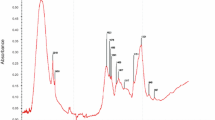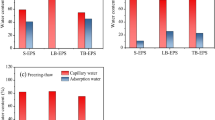Abstract
The stirred ball mill (SBM) method is a common method applied in large-scale sludge disintegration. Many reports focus on the disintegration results of sludge or the influence of parameters on the anaerobic process of treated sludge, but there have been few studies on the mechanism of sludge disintegration by SBM. This study focused on the mechanism of sludge disintegration by the SBM method. The results show that the flocs and bacterial cell wall were well disrupted and that the cytoplasm flowed remarkably out of the cell. Although the size with the largest volume distribution was expected to decrease with increasing treatment time, the volume of particles with a size of 34.56–44.04 μm increased in the sample treated for 60 min. We observed a temperature increase in the reflocculation of the biomacromolecules. The maximal value of DDCOD was 18.6%, and the concentrations of proteins and nucleic acids reached peaks at 691.80 mg/L and 281.05 mg/L, respectively. The peptidoglycan concentration showed that only 25.4% of the cell wall was broken and dissolved into liquid. From the results, we show that SBM can effectively break flocs and bacterial cell walls, but the method has a low efficiency for breaking biomacromolecule fragments into the liquid phase.
Graphic Abstract












Similar content being viewed by others
References
Peng, H., Li, H., Luo, H., Xu, J.: A novel combined pretreatment of ball milling and microwave irradiation for enhancing enzymatic hydrolysis of microcrystalline cellulose. Biores. Technol. 130, 81–87 (2013). https://doi.org/10.1016/j.biortech.2012.10.167
Spinosa, L.: Wastewater sludge: a global overview of the current status and future prospects. Water Intell. Online (2011). https://doi.org/10.2166/9781843393887
Weemaes, M.P.J., Verstraete, W.H.: Evaluation of current wet sludge disintegration techniques. J. Chem. Technol. Biotechnol. 73, 83–92 (1998)
Pavlostathis, S.G., Gosset, J.M.: A kinetic model for anaerobic digestion of biological sludge. Biotechnol. Bioeng. 27, 1519–1530 (1986)
Harrison, S.T.L.: Bacterial cell disruption: a key unit operation in the recovery of intracellular products. Biotechnol. Adv. 9, 217E40 (1991)
Kampas, P., Parsons, S.A., Pearce, P., Ledoux, S., Vale, P., Churchley, J., Cartmell, E.: Mechanical sludge disintegration for the production of carbon source for biological nutrient removal. Water Res. 41, 1734–1742 (2007)
Chockalingam, L.R., Johannes, M., Georg, S., Paruchuri, G.R.: Microbial growth reduction in sewage sludge by stirred ball mill disintegration and estimation by respirometry. J. Chem. Technol. Biotechnol. 83, 269–278 (2008)
Gonze, E., Pillot, S., Valette, E., Gonthier, Y., Bernis, A.: Ultrasonic treatment of an aerobic activated sludge in a batch reactor. Chem. Eng. Process. 42, 965–975 (2003)
Woon-Ji, P., Johng-Hwa, A., Seokhwan, H., Chan-Ki, L.: Effect of output power, target temperature, and solid concentration on the solubilization of waste activated sludge using microwave irradiation. Biores. Technol. 101, S13–S16 (2010)
Wilson, C.A., Novak, J.T.: Hydrolysis of macromolecular components of primary and secondary wastewater sludge by thermal hydrolytic pretreatment. Water Res. 43, 4489–4498 (2009)
Zhang, L., Xu, C.: Pascale Champagne. Energy recovery from secondary pulp/paper-mill sludge and sewage sludge with supercritical water treatment. Bioresour. Technol. 101, 2713–2721 (2010)
Chu, L.B., Yan, S.T., Xing, X.H., Yu, A.F., Sun, X.L., Benjamin, J.: Enhanced sludge solubilization by microbubble ozonation. Chemosphere 72, 205–212 (2008)
Yang, J., Ji, M., Han, Y., Liu, W., Zhang, X.: Effect of alkaline and ultrasonic pretreatment on the sludge disintegration. Environ. Sci. 29, 1002–1006 (2008)
Chisti, Y., Young, M.M.: Disruption of microbial cells for intracellular products. Enzyme Microb Technol. 8, 194–204 (1986)
Kopp, J., Muller, J., Dichtl, N., Schwedes, J.: Anaerobic digestion and dewatering characteristics of mechanically disintegrated excess sludge. Water Sci Technol. 30, 129–136 (1997)
Winter, A.: Minimization of costs by using disintegration at a full scale anaerobic digestion plant. Water Sci. Technol. 46, 405–412 (2002)
Mueller, J.: Sewage sludge disintegration as a key step in sewage sludge treatment. Water Sci. Technol. 41, 123–130 (2000)
Schmitz, U., Berger, C.R., Orth, H.: Protein analysis as a simple method for the quantitative assessment of sewage sludge disintegration. Water Res. 34, 3682–3685 (2000)
Sridhar, P., Puspendu, B., Song, Y., LeBlanc, R.J., Tyagi, R.D., Surampalli, R.Y.: Ultrasonic pretreatment of sludge: a review. Ultrason. Sonochem. 18, 1–18 (2011)
Kumar Khana, S., Grewell, D., Sung, S., (Hans) Van Leeuwen, J.: Ultrasound applications in wastewater sludge pretreatment: a review. Crit. Rev. Environ. Sci. Technol. 37, 277–313 (2007)
Sekine, K., Tomohiro, T., Minoru, S., Morio, K., Kawashima, T., Hashimoto, Y.: Higher efficacy on the regression of an established tumor in (whole peptidoglycan) from Bifidobacterium infantis with a new morphologically characterized cell wall preparation. Can. Res. 45, 1300–1307 (1985)
Leslie, A.E., Walter, T.J.M.: A colorimetric method for the determination of glucosamine and chondrosamine. Biochem. J. 27, 1824–1828 (1933)
Manuel, M.: Manuel Maldonado Intergenerational transmission of symbiotic bacteria in oviparous and viviparous demosponges, with emphasis on intracytoplasmically-compartmented bacterial types. J. Mar. Biol. Assoc. UK 87, 1701 (2007)
Jorand, F., Zartarian, F., Thomas, F., Block, J.C., Bottero, J.Y., Villemin, G., Urbain, V., Manem, J.: Chemical and structural (2D) linkage between bacteria within activated sludge flocs. War. Res. 29, 1639–1647 (1995)
Forster, C.F., Knight, N.J.B., Wase, D.A.J.: Flocculating agents of microbial origin. Adv. Biotechnol. Proc. 4, 211–240 (1985)
Vallom, J.K., McLoughlin, A.J.: Lysis as a factor in sludge flocculation. Water Res. 18, 1523–1528 (1984)
Biggs, C., Lant, P.: Identifying the mechanisms of activated sludge flocculation. Environmental Engineering Research Event. 6–9 (1998)
Sekine, K., Tomohiro, T., Saito, M., Kuboyama, M., Kawashima, T., Hashimoto, Y.: A new morphologically characterized cell wall preparation (whole peptidoglycan) from Bifidobacterium infantis with a higher efficacy on the regression of an established tumor in mice. Cancer Res. 45, 1300–1307 (1985)
Acknowledgements
This work was supported by the National Natural Science Foundation of China (Grant No. 21677030), Project of Shenyang Young and Middle-aged Science and Technology Innovation Talents (Grant No. RC18036) and the Set Sail Plan for Science and Technology Project of Shenyang (Grant No. 18-201-0-09).
Author information
Authors and Affiliations
Corresponding authors
Ethics declarations
Conflict of interest
Sai Yao, Feng Ma, Baorui Liang, Youzhao Wang, Yuanhua Xie, Liying Hao, Tong Zhu have no competing interests to declare.
Additional information
Publisher's Note
Springer Nature remains neutral with regard to jurisdictional claims in published maps and institutional affiliations.
Rights and permissions
About this article
Cite this article
Yao, S., Ma, F., Liang, B. et al. Mechanism Investigation of Excess Sludge Disintegration by Stirred Ball Mill—Utilized Transmission Electron Microscope Observation and Peptidoglycan Concentration Determination. Waste Biomass Valor 12, 6543–6554 (2021). https://doi.org/10.1007/s12649-021-01478-y
Received:
Accepted:
Published:
Issue Date:
DOI: https://doi.org/10.1007/s12649-021-01478-y




